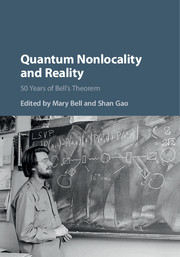Book contents
- Frontmatter
- Contents
- Contributors
- Preface
- Preface
- Part I John Stewart Bell: The Physicist
- Part II Bell's Theorem
- Part III Nonlocality: Illusion or Reality?
- 9 Strengthening Bell's Theorem: Removing the Hidden-Variable Assumption
- 10 Is Any Theory Compatible with the Quantum Predictions Necessarily Nonlocal?
- 11 Local Causality, Probability and Explanation
- 12 The Bell Inequality and the Many-Worlds Interpretation
- 13 Quantum Solipsism and Nonlocality
- 14 Lessons of Bell's Theorem: Nonlocality, Yes; Action at a Distance, Not Necessarily
- 15 Bell Nonlocality, Hardy's Paradox and Hyperplane Dependence
- 16 Some Thoughts on Quantum Nonlocality and Its Apparent Incompatibility with Relativity
- 17 A Reasonable Thing That Just Might Work
- 18 Weak Values and Quantum Nonlocality
- Part IV Nonlocal Realistic Theories
- Index
- References
15 - Bell Nonlocality, Hardy's Paradox and Hyperplane Dependence
from Part III - Nonlocality: Illusion or Reality?
Published online by Cambridge University Press: 05 September 2016
- Frontmatter
- Contents
- Contributors
- Preface
- Preface
- Part I John Stewart Bell: The Physicist
- Part II Bell's Theorem
- Part III Nonlocality: Illusion or Reality?
- 9 Strengthening Bell's Theorem: Removing the Hidden-Variable Assumption
- 10 Is Any Theory Compatible with the Quantum Predictions Necessarily Nonlocal?
- 11 Local Causality, Probability and Explanation
- 12 The Bell Inequality and the Many-Worlds Interpretation
- 13 Quantum Solipsism and Nonlocality
- 14 Lessons of Bell's Theorem: Nonlocality, Yes; Action at a Distance, Not Necessarily
- 15 Bell Nonlocality, Hardy's Paradox and Hyperplane Dependence
- 16 Some Thoughts on Quantum Nonlocality and Its Apparent Incompatibility with Relativity
- 17 A Reasonable Thing That Just Might Work
- 18 Weak Values and Quantum Nonlocality
- Part IV Nonlocal Realistic Theories
- Index
- References
Summary
Abstract
I begin with some reminiscences of my delayed appreciation of the significance of John Bell'swork. Preparatory remarks on my general perspective concerning the interpretation of quantum mechanics are presented. I argue against the conflation of hyperplane dependence with frame dependence, which occurs occasionally; and that the ‘elements of reality’ of Hardy's famous gedankenexperiment can retain their Lorentz invariance, i.e., their frame independence, if one recognizes the hyperplane dependence of their localization, which follows. Finally, I criticize a view of the nature of Lorentz transformations presented by Asher Peres and co-workers which conflicts with the view employed here.
Initial Reactions to Bell's Work
Like many others in the physics community, I was late to come to an appreciation of the significance of John Bell's papers on the foundations of quantum mechanics (QM). But unlike many of those, my indifference to Bell was not due to a dismissive attitude to foundational studies per se or to an intransigent commitment to some version of Copenhagenism. In 1971, for example, I was very much involved in the international conference on QM foundations at my home institution, where Bell presented the paper “On the hypothesis that the Schrödinger equation is exact,” published later as [1], but I paid minimal attention to his presentation. The cause of this poor judgment (as I eventually came to realize it was) was that I was already convinced that the Schrödinger equation was not exact in the sense Bell meant, but must be augmented with primordial state reductions. I was among those who, in the words of Bob Wald, as reported by Roger Penrose [2], were inclined to “take it seriously,” the QM state that is, and, consequently, could not “really believe in it,” i.e., really believe that purely unitary QM is a complete theory. I was delighted when the experimental tests of Bell's inequalities upheld the QM predictions. I was, furthermore, uninterested in hidden variable reconstructions of QM, such as Bohmian mechanics [3] and Many Worlds interpretations [4, 5], that were, in principle, not susceptible to empirical tests of their novel details.
- Type
- Chapter
- Information
- Quantum Nonlocality and Reality50 Years of Bell's Theorem, pp. 261 - 280Publisher: Cambridge University PressPrint publication year: 2016



